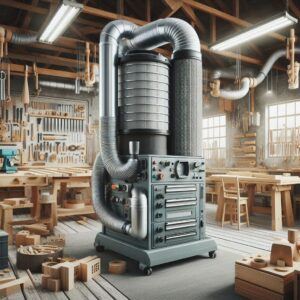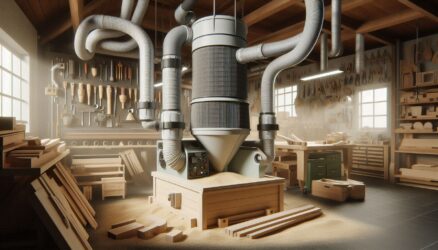Keep Your Shop Clean, Safe, and Efficient
One of the biggest challenges in a small woodworking shop isn’t lack of space — it’s controlling the dust. While it may seem harmless, fine sawdust poses serious risks to your health, your tools, and your workflow. Even a few hours of sanding or cutting MDF can leave your shop coated in a fine, hazardous layer. That’s why I’m here to help you with the best dust collection solutions for a small workshop.
Fortunately, you don’t need a massive cyclone system or industrial setup to maintain good air quality. In this guide, we’ll break down the best dust collection solutions for a small workshop — including portable systems, shop vacs, air filtration units, and smart shop layouts — to help you build a cleaner, safer workspace.
🚨 Why Dust Collection Matters
Before we dive into the tools and systems, let’s quickly look at why dust collection is so essential — even in hobby or garage-based woodshops.
🔴 Health Risks
- Fine particulate matter (especially from MDF or hardwood) can cause respiratory irritation and long-term lung damage.
- Wood dust is a known carcinogen according to OSHA.
- Airborne dust lingers, and it can affect not only your lungs, but also your eyes, skin, and sinuses.
🟠 Fire Hazard
- Dry wood dust is highly flammable.
- A spark from a tool or extension cord can ignite dust in the air or collection bin.
🟡 Tool Efficiency
- Clogged tools and motors run hotter and wear out faster.
- Chips and dust can dull blades, sandpaper, and bits more quickly.
🟢 Clean Workspace
- A tidy shop helps you stay productive and reduces tripping hazards and tool damage.
As an Amazon Associate, I earn from qualifying purchases.
🧰 1. Shop Vacuums: Budget-Friendly and Powerful
If you’re just getting started, a high-quality shop vac is the easiest and most affordable way to collect dust at the source.
Features to Look For:
- Minimum 6.5 HP peak power
- Large capacity drum (at least 10 gallons)
- HEPA or fine-particle filter
- Compatible with a cyclone separator
Pros:
- Affordable (starting around $100)
- Portable—can follow you from tool to tool
- Versatile for both dry and wet messes
Cons:
- Needs frequent emptying
- Can be loud
- Suction may drop with small hoses or clogged filters
Recommended Models:
- RIDGID WD1450 14-Gallon
- Shop-Vac HEPA 5989305
- Fein Turbo II (quiet and compact)
💡 Pro Tip: Add a cyclone separator (like the Dust Deputy) to reduce filter clogs and extend vac life.
🌪️ 2. Cyclone Separators: Clean Air + Clean Filter
Cyclone separators work by spinning dust and chips out of the air stream before it reaches your shop vac or dust collector. This keeps your main filter clean and improves suction.
Best Options:
- Oneida Dust Deputy (works with most shop vacs)
- Super Dust Deputy XL (for larger setups)
- Homemade cyclone lids (DIY-friendly)
Benefits:
- Captures 95–99% of dust before it hits your vacuum
- Reduces filter cleaning dramatically
- Saves time and maintenance costs
Attach a cyclone between your vac and tool using flexible 2.5″ or 4″ hoses.
🏭 3. Compact Dust Collectors
If you have several stationary tools (table saw, planer, jointer), upgrading to a dedicated dust collector makes sense.
Recommended Units for Small Shops:
- JET DC-650 – Affordable, mobile, and powerful
- Grizzly G8027 1 HP – Solid performance for the price
- Harbor Freight 2 HP – Budget-friendly with mods
Key Features:
- At least 1 HP motor
- 4″ inlet
- 600–800+ CFM (cubic feet per minute) airflow
- Optional wall-mount for space saving
Pros:
- Handles larger chips and dust more effectively
- Quieter than most shop vacs
- Can be used with multiple tools (with blast gates)
Cons:
- More expensive upfront
- Takes up floor or wall space
- Requires proper hose routing
💡 Install a remote power switch so you can turn the unit on/off from anywhere in the shop.
🌬️ 4. Air Filtration Units
Even with at-source dust collection, fine airborne dust will still circulate—especially after sanding. That’s where ambient air filtration systems come in.
Top Picks:
- WEN 3410 Air Filtration System
- JET AFS-1000B
- DIY box fan + furnace filter combo (cheap but effective)
What to Look For:
- Dual filtration (1 micron and 5 micron pre-filter)
- Adjustable speed and timer
- Ceiling-mount capability to save space
Hang one in the center of your shop, and let it run for 30–60 minutes after you finish cutting or sanding.
🧱 5. Shop Layout Tips for Better Dust Control
Even the best vacuum won’t help much if your workflow creates unnecessary mess. Use these smart layout and workflow tips:
Set Up Dusty Tools Near the Door
Place high-dust producers (table saw, planer, miter saw) near a window or door for easy venting.
Use Anti-Static Hoses
Static electricity can build up in dust systems. Anti-static hoses reduce risk and last longer.
Install Blast Gates
Control airflow by opening only the tool you’re using. This boosts suction and prevents loss of airflow to unused tools.
Keep Floor Clear
Run dust hoses along the wall or ceiling to reduce tripping hazards and preserve shop space.

🧼 Maintenance Matters
To keep your dust collection system working smoothly:
- Empty bins regularly to prevent clogs and reduced airflow
- Clean filters weekly, especially after sanding MDF or pine
- Check hoses for blockages if suction drops
- Label hoses and blast gates for quick switching
- Inspect seals and gaskets to prevent air leaks
Regular maintenance takes just minutes and ensures your system performs at its peak.
💡 Bonus: DIY Dust Collection Hacks
If you’re building on a budget, here are some shop-tested DIY dust solutions:
Bucket Cyclone Separator
- Use a 5-gallon bucket, a lid, and cyclone insert
- Great for sanding and router tables
PVC Pipe Network
- Replace expensive flex hose with 4” PVC drain pipe
- Use blast gates at each station
Shop Vac Cart
- Build a rolling cart with vac + cyclone + storage
- Saves space and keeps everything mobile
📊 Comparison Chart: Best Dust Collection Options for Small Shops
Solution Best For Cost Size Maintenance Efficiency
Shop Vac Beginners, mobile use $100–$200 Compact High Medium
Cyclone Separator Dust control + filter life $60–$150 Medium Low High
Dust Collector Stationary tools $250–$600 Medium–Large Medium High
Air Filtration Unit Floating dust $130–$400 Medium (ceiling) Low High
DIY Box Fan Budget air cleaning $25–$50 Small Low Medium
** Here’s a little transparency: Our website contains affiliate links. This means if you click and make a purchase, we may receive a small commission. Don’t worry, there’s no extra cost to you. It’s a simple way you can support our mission to bring you quality content.**
✅ Final Thoughts
A clean shop is a productive shop. No matter how small your woodworking space is, there’s a dust collection solution that can fit your needs and budget.
You don’t need a $2,000 industrial unit to breathe clean air and protect your lungs. Start with a good shop vac and cyclone, add air filtration as needed, and organize your layout to keep dust under control.
With some smart planning and a little maintenance, your small shop can stay safe, clean, and efficient for years to come.
📸 Show Off Your Dust Setup!
Got a clever dust collection hack or compact layout to share? Tag @SawdustSmarty or use the hashtag #SmartSawdust on social media for a chance to be featured on the site!



